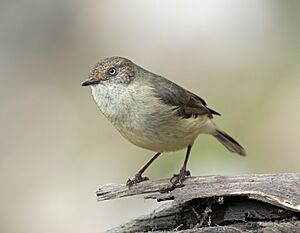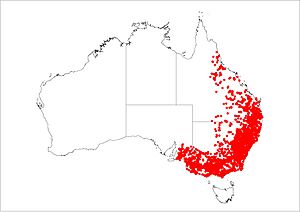Buff-rumped thornbill facts for kids
Quick facts for kids Buff-rumped thornbill |
|
|---|---|
 |
|
| Conservation status | |
| Scientific classification | |
| Genus: |
Acanthiza
|
| Species: |
reguloides
|
| Subspecies | |
|
|
The buff-rumped thornbill (Acanthiza reguloides) is a small bird found mostly in Australia. It's part of a group of birds called Acanthiza, which are known for their thin, pointy beaks.
This little bird is about 8–10 cm long. It has plain greenish-brown feathers on its back and very pale yellow feathers underneath. A special feature is its bright buff (yellowish-brown) coloured rump, which is the area just above its tail. Its tail also has a wide, dark band with a lighter tip. Adult buff-rumped thornbills have white eyes, but young birds have dark eyes.
Contents
About Their Family Tree (Taxonomy)
Scientists group animals together based on how they are related. The buff-rumped thornbill belongs to the Acanthiza group. Even though some of these birds look a bit different, scientists have decided they are all part of the same species.
There are four main types, or subspecies, of the buff-rumped thornbill:
- Acanthiza reguloides subsp. australis
- Acanthiza reguloides subsp. nesa
- Acanthiza reguloides subsp. reguloides
- Acanthiza reguloides subsp. squamata
Where Do They Live? (Habitat)
Buff-rumped thornbills mostly live in eastern Australia. You can find them from Queensland, across New South Wales, and into Victoria and southeastern South Australia. This area is huge, covering about 2 million square kilometers!
These birds are very good at adapting to different places. They like dry forests and open woodlands where eucalyptus trees grow. They prefer areas where the plants close to the ground are not too thick.
What Do They Eat?
The buff-rumped thornbill mainly eats small insects. They find these tiny bugs and plant lice on leaves. Sometimes, they also eat seeds.
How Do They Raise Their Young? (Reproduction)
Buff-rumped thornbills build a large, dome-shaped nest. They make it from strips of bark, dry grass, and moss. They usually place their nests about one to two meters off the ground. Inside, the nest is soft, lined with fur or plant fluff, and held together with spider webs on the outside.
These birds often work together to raise their chicks. A group usually has one female and three males. The female typically lays 2 to 4 eggs in late August. The eggs hatch after about 20 days, and all the chicks usually hatch at the same time. The adult birds in the group all help feed the young.
Sometimes, another bird called the Horsfield's bronze-cuckoo lays its eggs in the thornbill's nest. The cuckoo chick learns to sound like the thornbill chicks before it pushes them out of the nest.
How Do They Behave?
Buff-rumped thornbills are often seen in small, noisy groups of about 20 birds. During times when they are not breeding, these groups might join together to form even larger clans. They are always chirping and twittering as they look for food. Their calls sound like a quick "pitta-pitta-pitta-pit."
These birds are amazing acrobats! They can hang upside down while looking for food. When they fly, they move in a wavy pattern. They are also known to protect their own territory.
Are They Safe? (Conservation Status)
The good news is that buff-rumped thornbill populations are generally stable and safe in all the Australian states where they live. However, in some areas, building new houses and changing their natural homes has caused their numbers to go down a bit.



